CHEVROLET CAMARO 1997 4.G Service Manual
Manufacturer: CHEVROLET, Model Year: 1997, Model line: CAMARO, Model: CHEVROLET CAMARO 1997 4.GPages: 404, PDF Size: 20.96 MB
Page 41 of 404
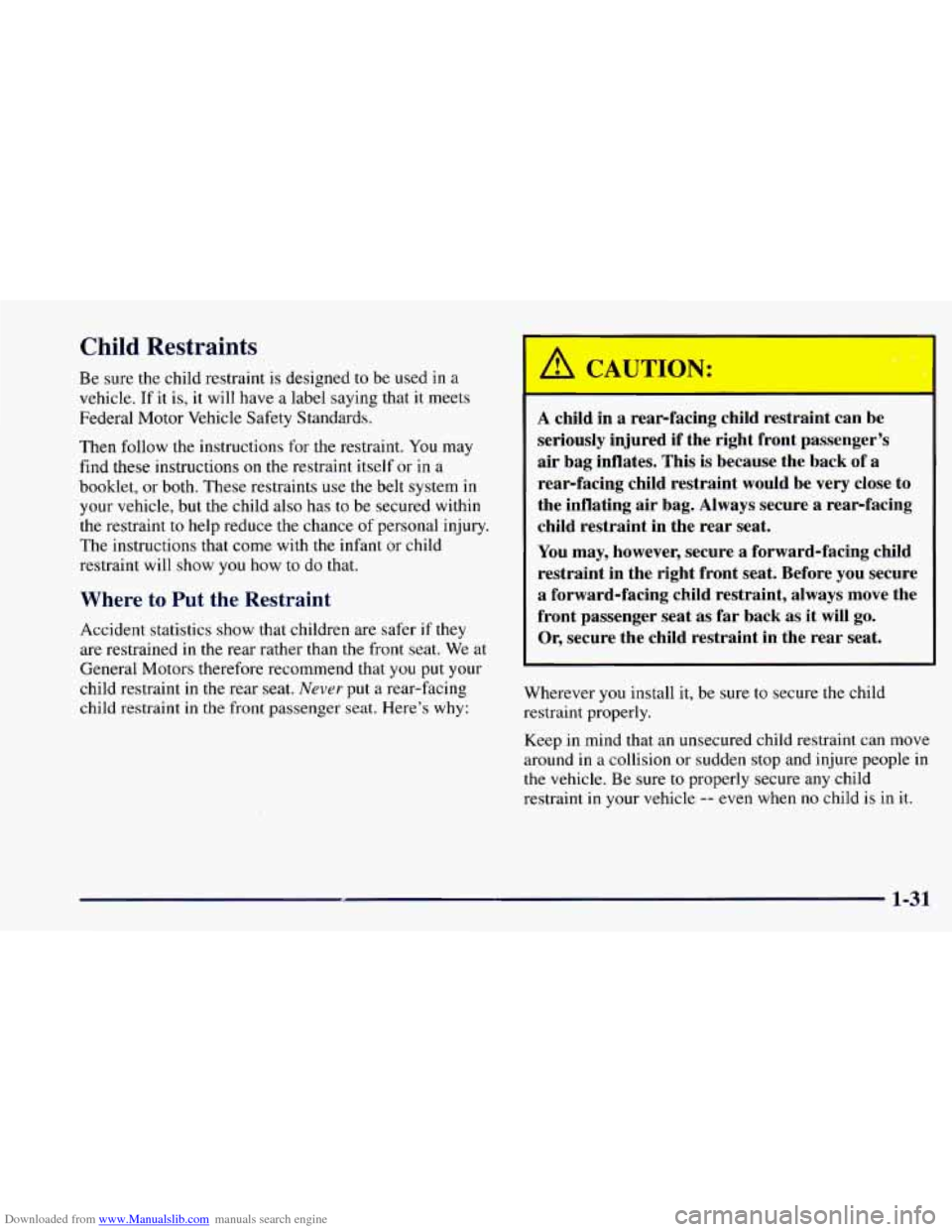
Downloaded from www.Manualslib.com manuals search engine r Child Restraints
Be sure the child restraint is designed to be used in a
vehicle. If
it is, it will have a label saying that it meets
Federal Motor Vehicle Safety Standards.
Then follow the instructions
for the restraint. You may
find these instructions on the restraint itself or
in a
booklet, or both. These restraints
use the belt system in
your vehicle, but the child also has
to be secured within
the restraint
to help reduce the chance of personal injury.
The instructions that come with
the infant or child
restraint will show
you how to do that.
Where to Put the Restraint
Accident statistics show that children are safer if they
are restrained in the rear rather than
the front seat. We at
General Motors therefore recommend that
you put your
child restraint in the rear seat.
Never put a rear-facing
child restraint in the front passenger seat. Here’s why:
A child in a rewfacing child restraint can be
seriously injured if the right front passenger’s
air bag inflates. This
is because the back of a
rear-facing child restraint would be very close to
the inflating air bag. Always secure a rear-facing
child restraint in the rear seat.
You
may, however, secure a forward-facing child
restraint in the right front seat. Before you secure
a forward-facing child restraint, always move the
front passenger seat as
far back as it will go.
Or, secure the child restraint in the rear seat.
Wherever you install it, be sure to secure the child
restraint properly.
Keep in mind that an unsecured child restraint can move
around in a collision or sudden stop and injure people in
the vehicle. Be sure
to properly secure any child
restraint in your vehicle
-- even when no child is in it.
1-31
Page 42 of 404
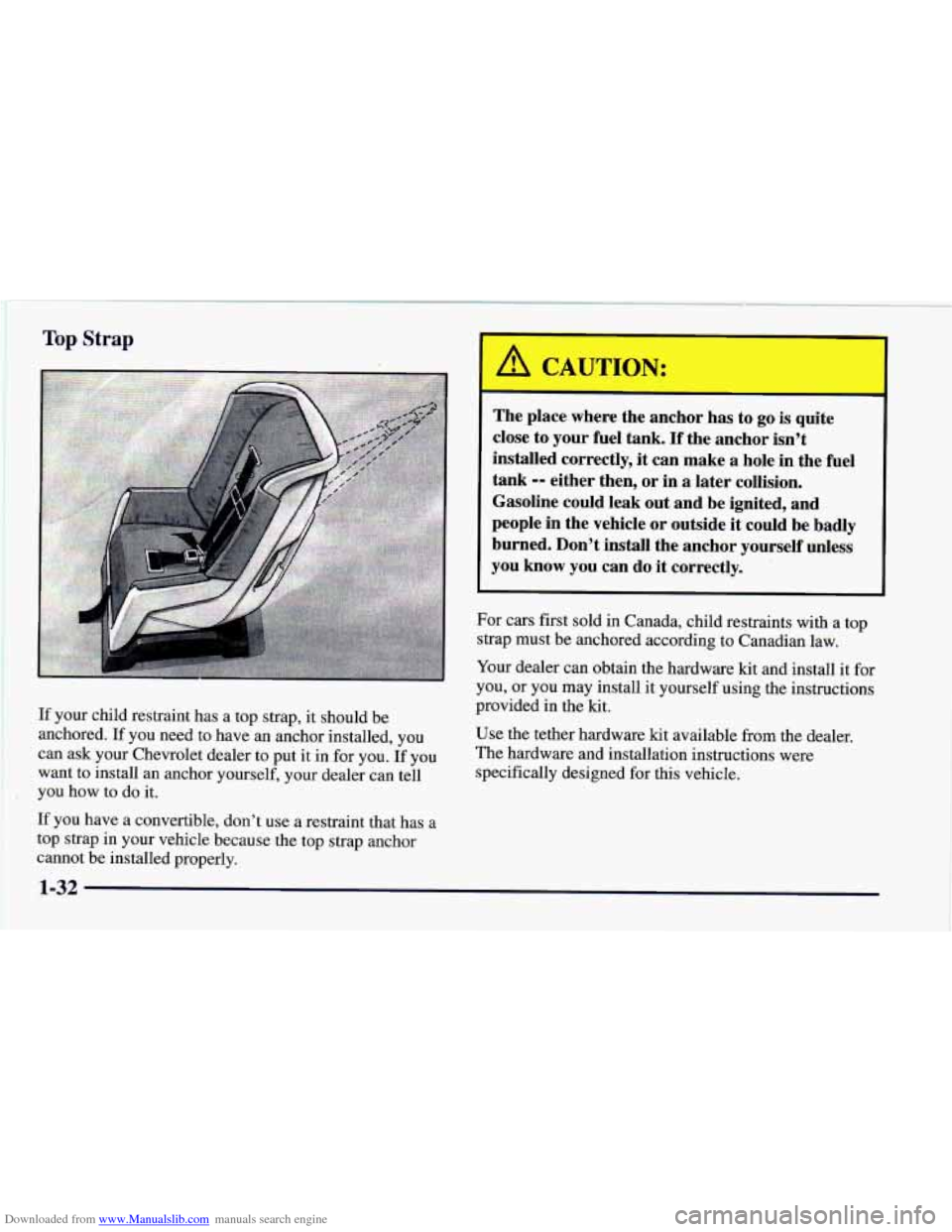
Downloaded from www.Manualslib.com manuals search engine Top Strap
1-32
Page 43 of 404
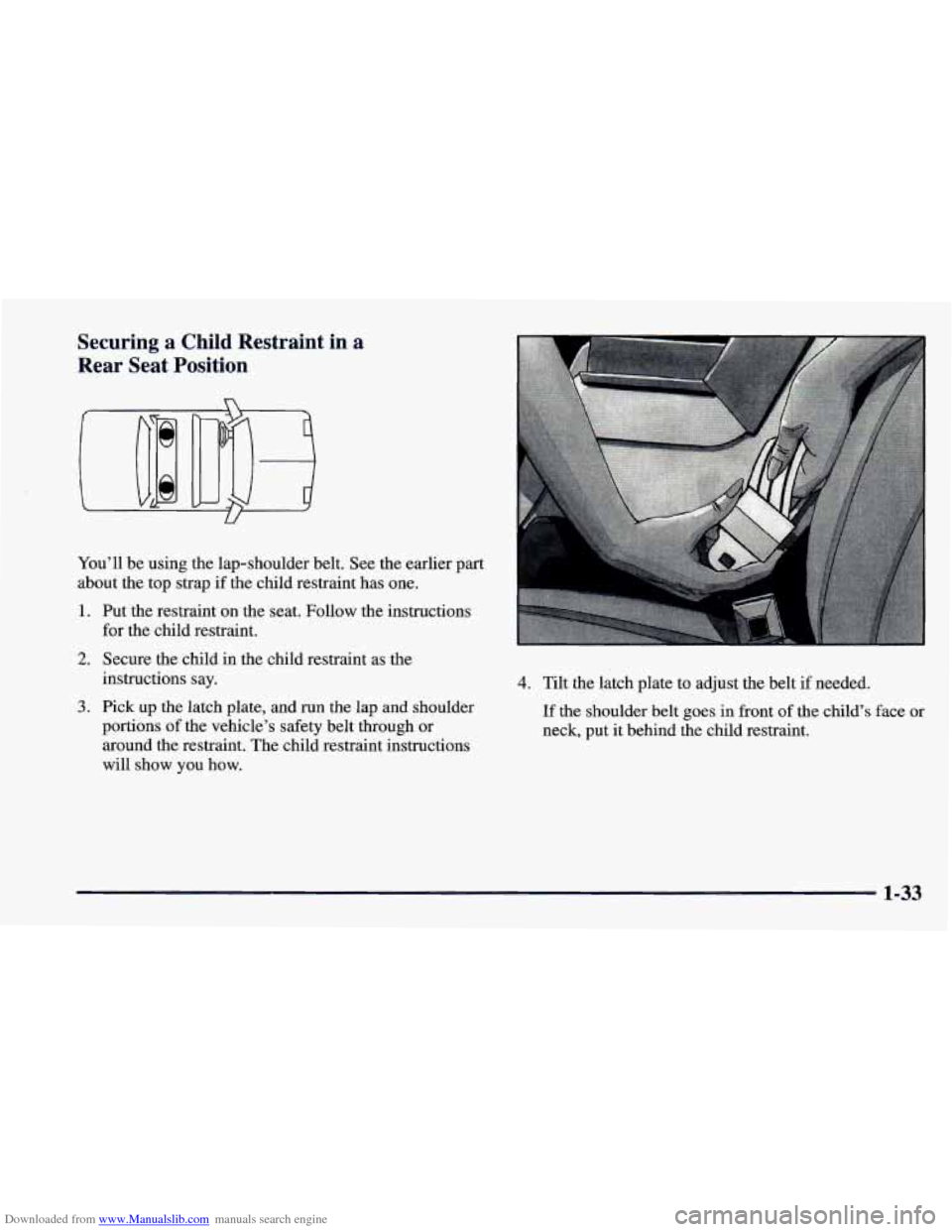
Downloaded from www.Manualslib.com manuals search engine Securing a Child Restraint in a
Rear Seat Position
n
W
You’ll be using the lap-shoulder belt. See the earlier part
about the top strap if the child restraint has one.
1. Put the restraint on the seat. Follow the instructions
for the child restraint.
2. Secure the child in the child restraint as the
instructions say.
3. Pick up the latch plate, and run the lap and shoulder
portions of the vehicle’s safety belt through or
around the restraint. The child restraint instructions
will show
you how.
4. Tilt the latch plate to adjust the belt if needed.
If the shoulder belt
goes in front of the child’s face or
neck, put it behind the child restraint.
1-33
Page 44 of 404
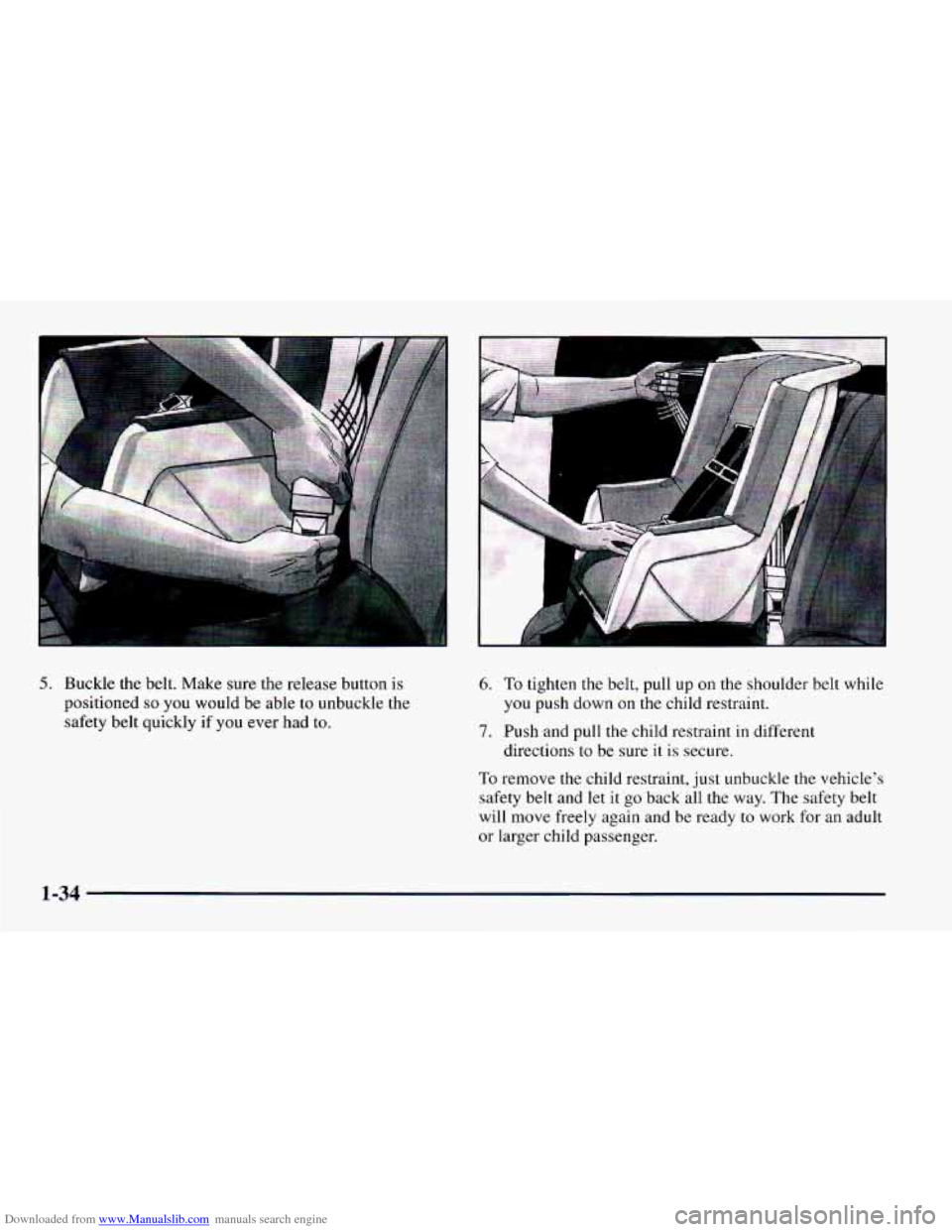
Downloaded from www.Manualslib.com manuals search engine 5. Buckle the belt. Make sure the release button is
positioned
so you would be able to unbuckle the
safety belt quickly if
you ever had to.
6. To tighten the belt, pull up on the shoulder belt while
you push down on the child restraint.
7. Push .and pull the child restraint in different
directions
to be sure it is secure.
To remove the child restraint, just unbuckle the vehicle’s
safety belt and
let it go back all the way. The safety belt
will move freely again and be ready to work for an adult
or larger child passenger.
1-34
Page 45 of 404
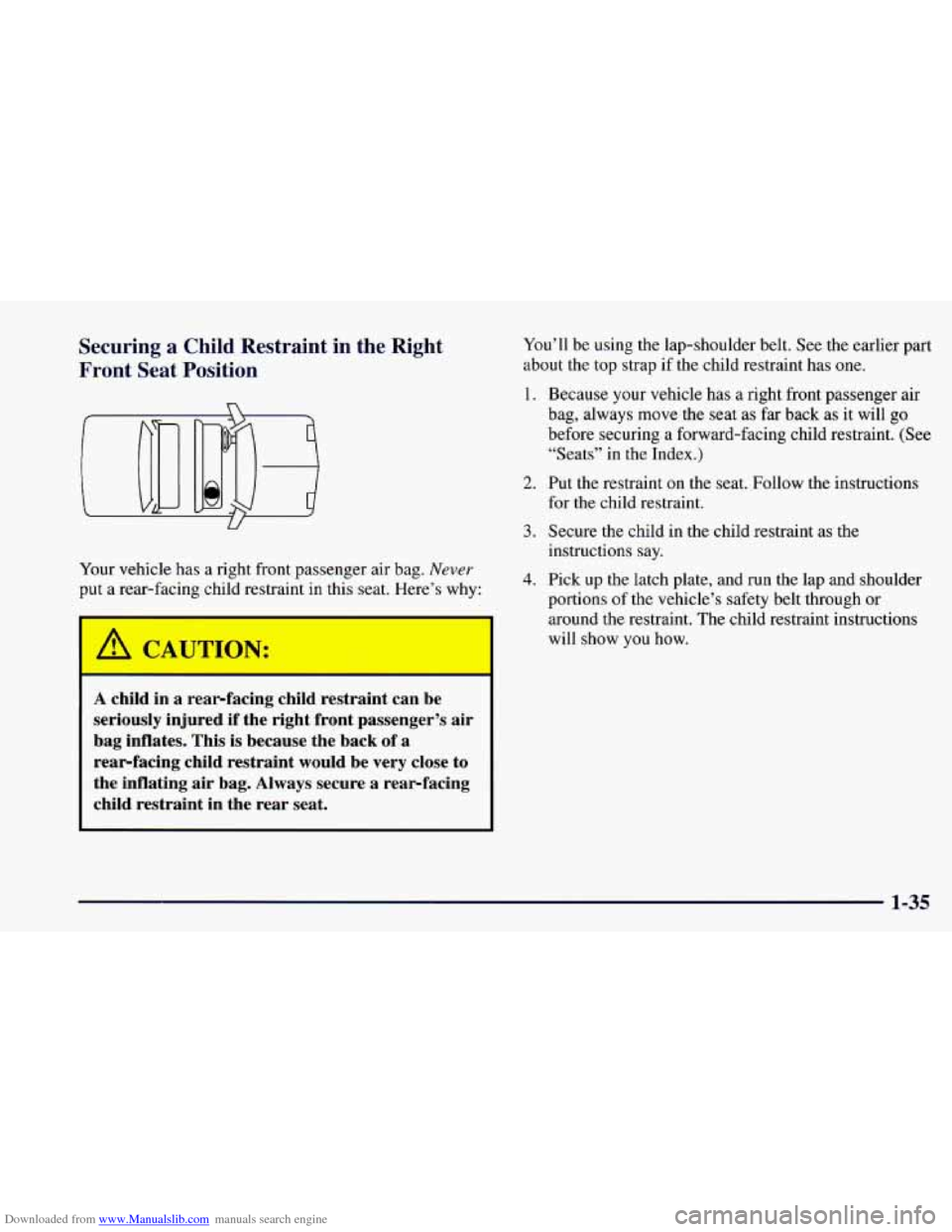
Downloaded from www.Manualslib.com manuals search engine Securing a Child Restraint in the Right
Front Seat Position
U
Your vehicle has a right front passenger air bag. Never
put a rear-facing child restraint in this seat. Here’s why:
ION:
A child in a rearfacing child restraint can be
seriously injured if the right front passenger’s air
bag inflates. This is because the back of a
rear-facing child restraint would be very close to
the inflating air bag. Always secure a rear-facing
child restraint in the rear seat.
You’ll be using the lap-shoulder belt. See the earlier part
about the top strap if the child restraint has one.
1. Because your vehicle has a right front passenger air
bag, always move the seat as far back as it will
go
before securing a forward-facing child restraint. (See
“Seats” in the Index.)
2. Put the restraint on the seat. Follow the instructions
for the child restraint.
3. Secure the child in the child restraint as the
instructions say.
4. Pick up the latch plate, and run the lap and shoulder
portions of the vehicle’s safety belt through or
around the restraint. The child restraint instructions
will show you how.
1-35
Page 46 of 404
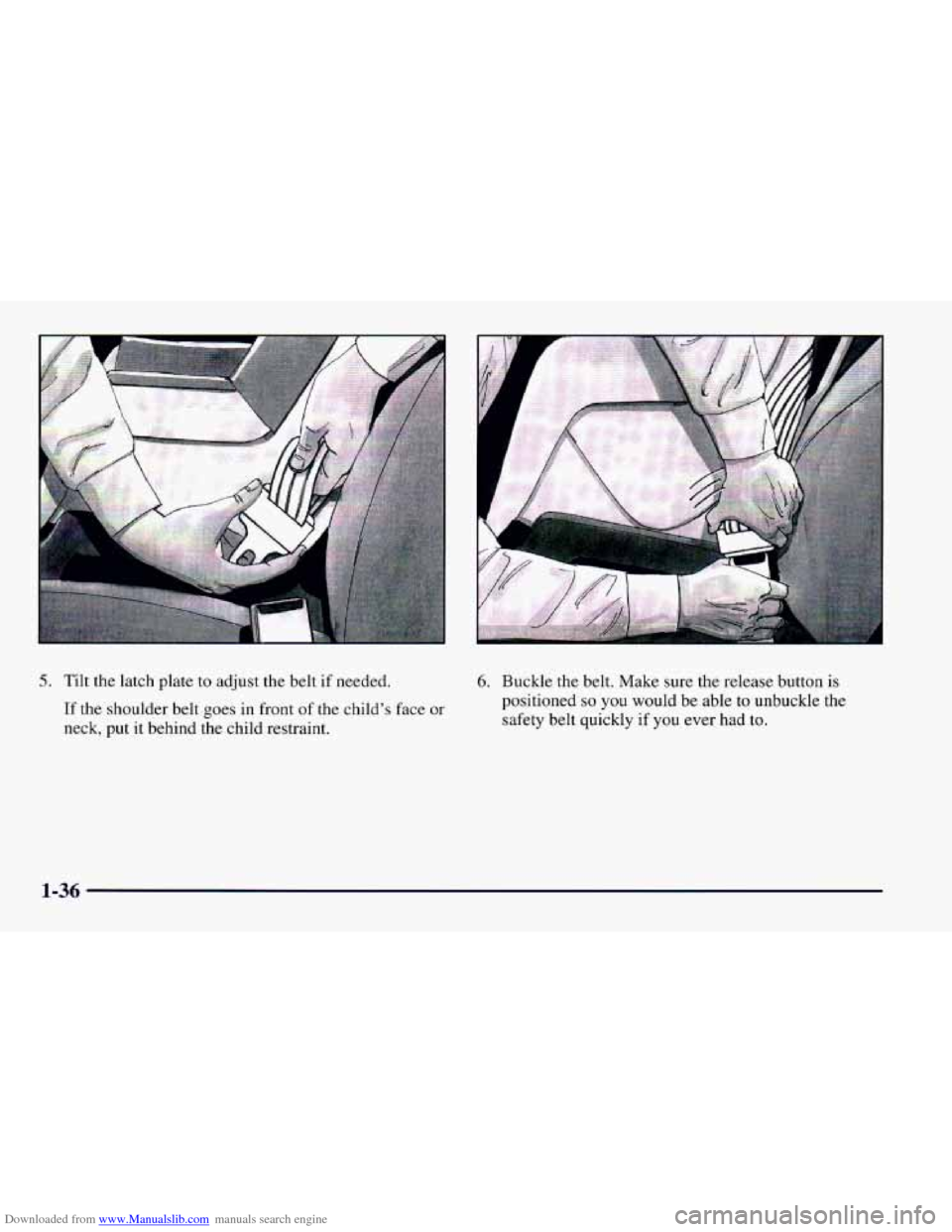
Downloaded from www.Manualslib.com manuals search engine 5. Tilt the latch plate to adjust the belt if needed.
If the shoulder belt goes in front
of the child’s face or
neck, put it behind the child restraint.
A
A
I‘
6. Buckle the belt. Make sure the release button is
positioned so you would be able to unbuckle the
safety belt quickly if you ever had to.
1-36
Page 47 of 404
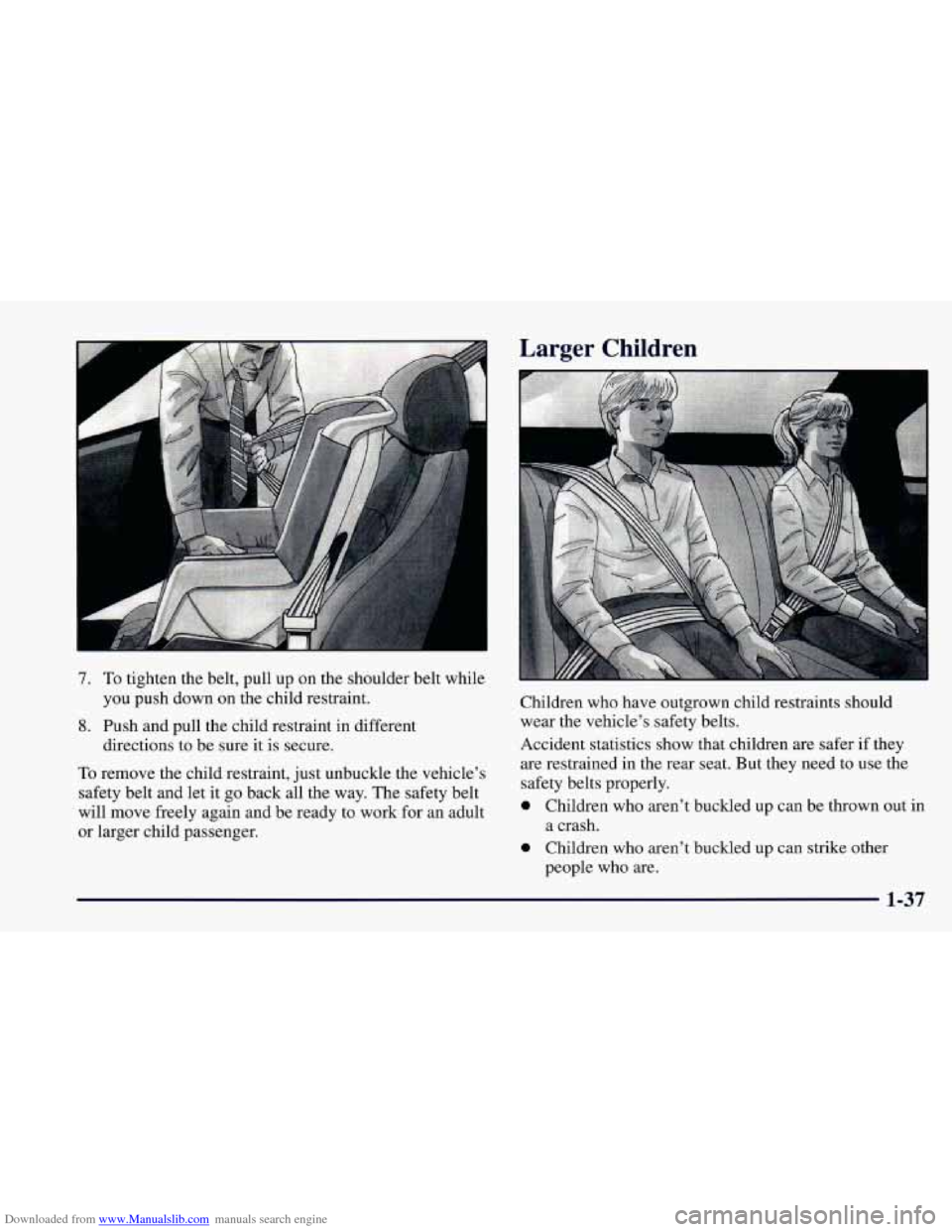
Downloaded from www.Manualslib.com manuals search engine 7. To tighten the belt, pull up on the shoulder belt while
you push down on the child restraint.
8. Push and pull the child restraint in different
directions to be sure it is secure.
To remove the child restraint, just unbuckle the vehicle’s
safety belt and let it go back all the way. The safety belt
will move freely again and be ready to work for an adult
or larger child passenger.
Larger Children
I
Children who have outgrown child restraints should
wear the vehicle’s safety belts.
Accident statistics show that children are safer if they
are restrained
in the rear seat. But they need to use the
safety belts properly.
0 Children who aren’t buckled up can be thrown out in
0 Children who aren’t buckled up can strike other
a crash.
people who are.
1-37
Page 48 of 404
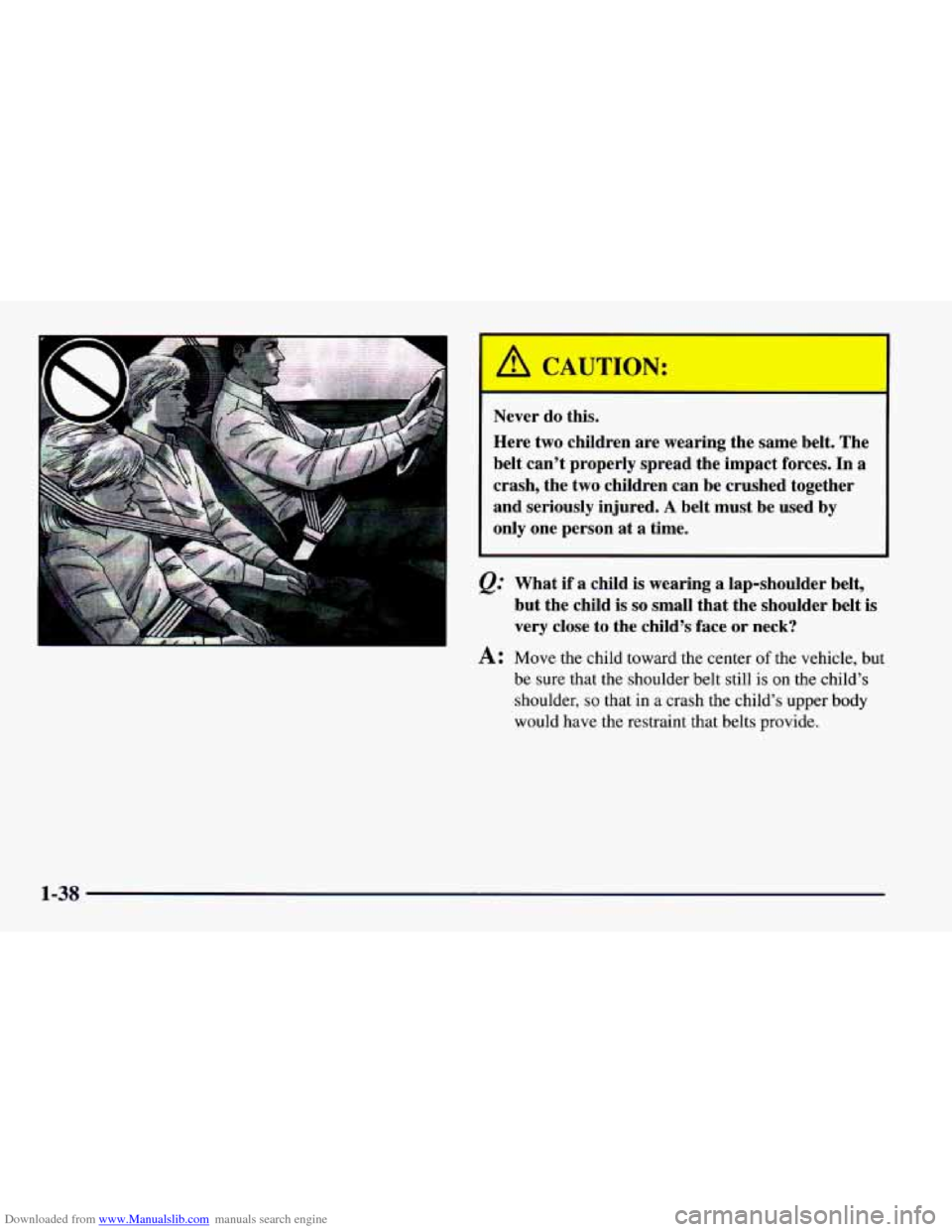
Downloaded from www.Manualslib.com manuals search engine A CAUTION:
Never do this.
Here two children are wearing the
same belt. The
belt can’t properly spread the impact
forces. In a
crash, the two children can be crushed together
and seriously injured.
A belt must be used by
only one person at a time.
What
if a child is wearing a lap-shoulder belt,
but the child is
so small that the shoulder belt is
very close to the child’s face
or neck?
A: Move the child toward the center of the vehicle, but
be sure that
the shoulder belt still is on the child’s
shoulder,
so that in a crash the child’s upper body
would have the restraint that belts provide.
1-38
Page 49 of 404
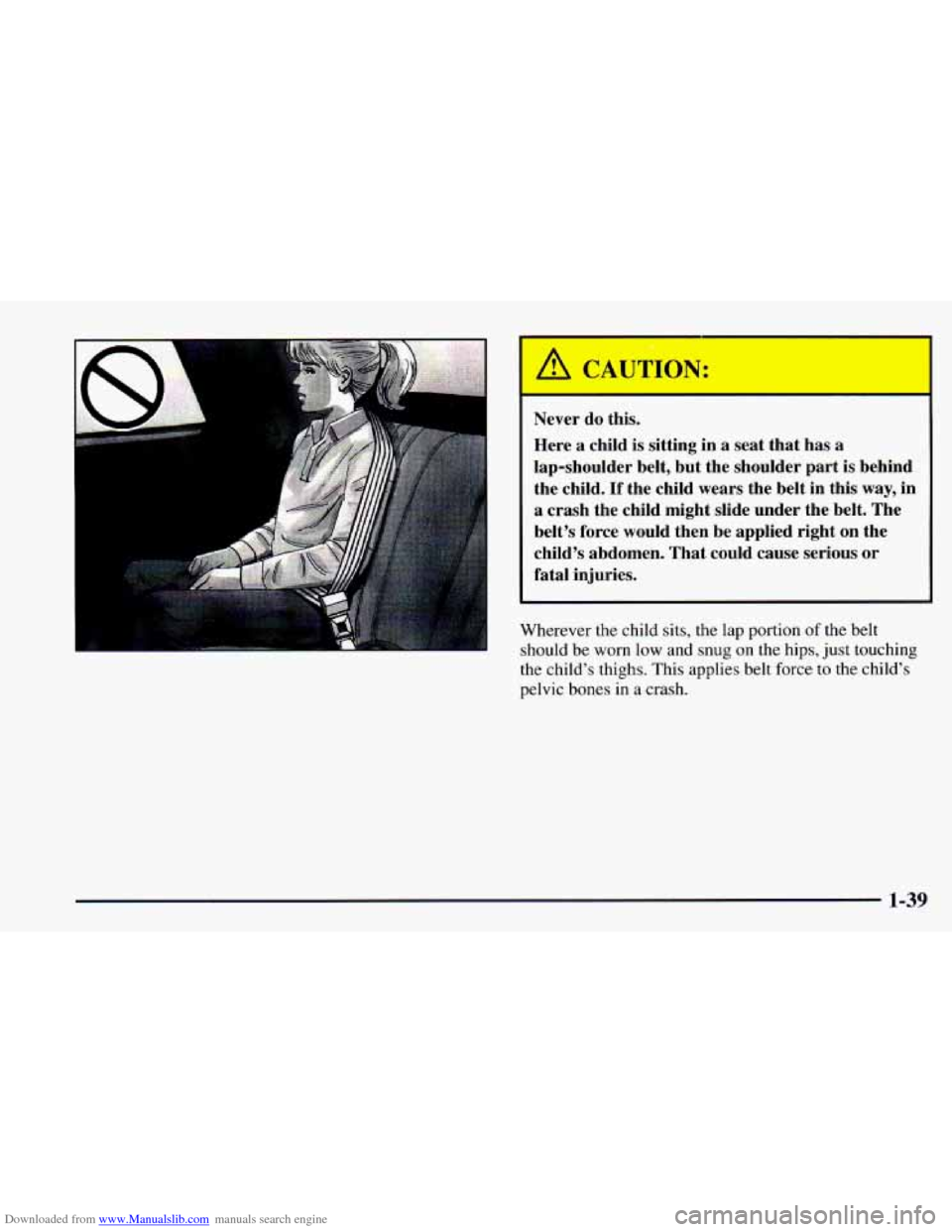
Downloaded from www.Manualslib.com manuals search engine I Never do this.
Here
a child is sitting in a seat that has a
lap-shoulder belt, but the shoulder part is behind
the child.
If the child wears the belt in this way, in
a crash the child might slide under the belt. The
belt’s force would then be applied right on the
child’s abdomen. That could cause serious or
fatal injuries.
Wherever the child sits, the lap portion of the belt
should be worn low and snug
on the hips, just touching
the child’s thighs. This applies belt force to the child’s
pelvic bones in a crash.
1-39
Page 50 of 404
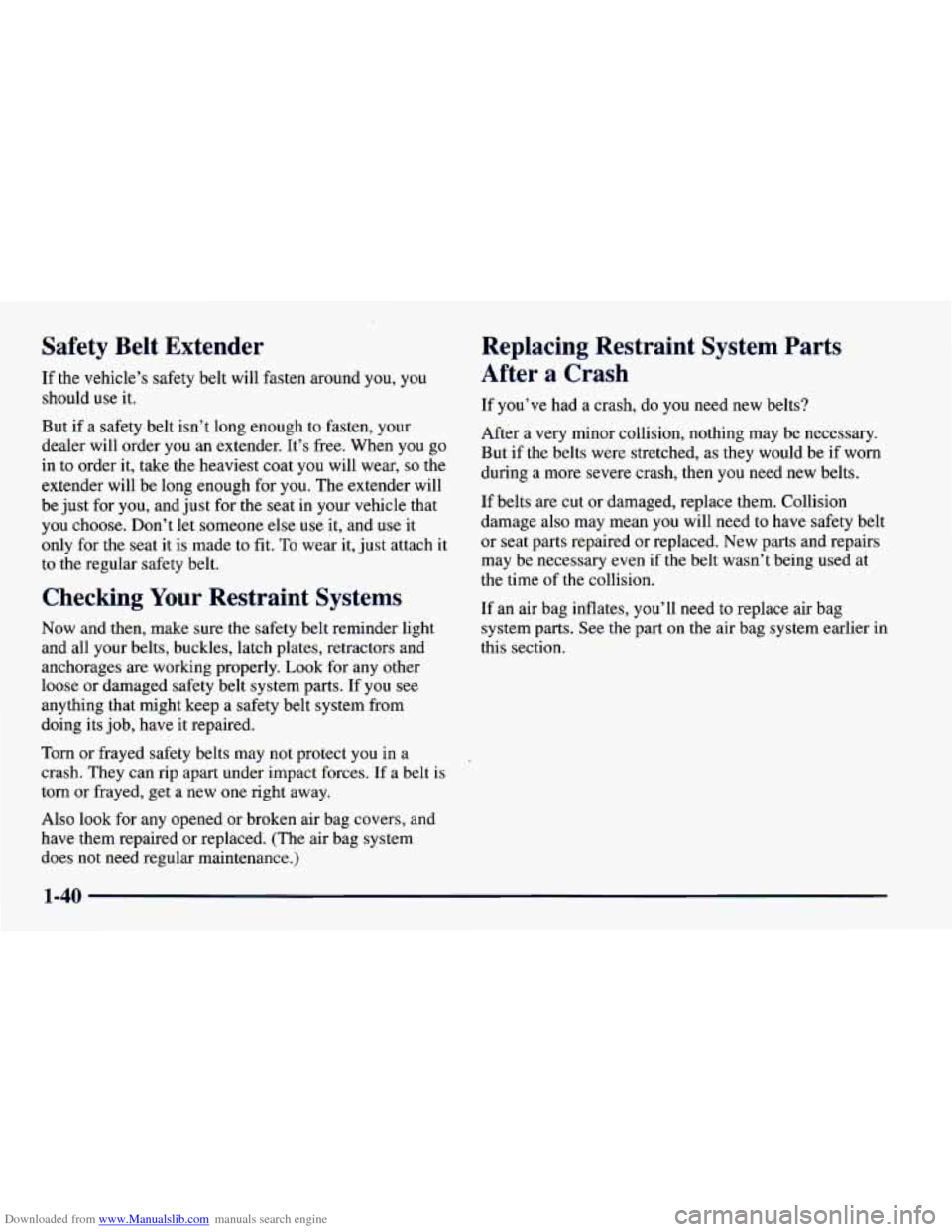
Downloaded from www.Manualslib.com manuals search engine Safety Belt Extender
If the vehicle’s safety belt will fasten around you, you
should
use it.
But if a safety belt isn’t long enough to fasten, your
dealer will order you an extender. It’s free. When you go
in to order it, take the heaviest coat you will wear,
so the
extender will be
long enough for you. The extender will
be just for you, and just
for the seat in your vehicle that
you choose. Don’t let someone else use it, and use it
only
for the seat it is made to fit. To wear it, just attach it
to the regular safety belt.
Checking Your Restraint Systems
Now and then, make sure the safety belt reminder light
and all your belts, buckles, latch plates, retractors and
anchorages are working properly. Look for any other
loose or damaged safety belt system parts.
If you see
anything that might keep a safety belt system from
doing its job, have it repaired.
Torn or frayed safety belts may not protect you in a
crash. They can rip apart under impact forces.
If a belt is
torn or frayed, get a new one right away.
Replacing Restraint System Parts
After a Crash
If you’ve had a crash, do you need new belts?
After a very minor collision, nothing may be necessary.
But if the belts were stretched, as they would be if worn
during a more severe crash, then you need new belts.
If belts are cut or damaged, replace them. Collision
damage also may mean
you will need to have safety belt
or seat parts repaired or replaced. New
parts and repairs
may be necessary even if the belt wasn’t being used at
the time of the collision.
If an air bag inflates, you’ll need to replace air bag
system parts. See the part on the air bag system earlier in
this section.
Also look for any opened or broken air bag covers, and
have them repaired or replaced. (The air bag system
does not need regular maintenance.)